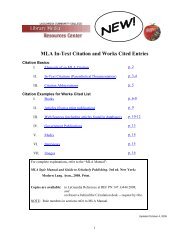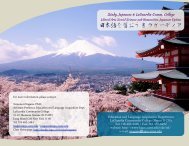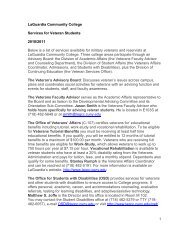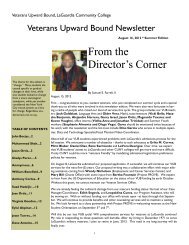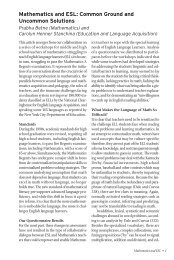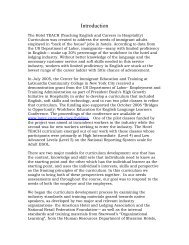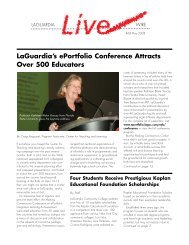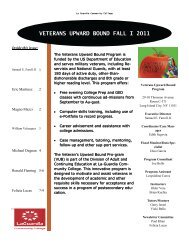Here - LaGuardia Community College - CUNY
Here - LaGuardia Community College - CUNY
Here - LaGuardia Community College - CUNY
Create successful ePaper yourself
Turn your PDF publications into a flip-book with our unique Google optimized e-Paper software.
One-Time Competitive Grants Program (2c):<br />
Study Abroad by <strong>LaGuardia</strong> Visual Arts Students in Chile<br />
Introduction to <strong>LaGuardia</strong> <strong>Community</strong> <strong>College</strong><br />
In many ways, <strong>LaGuardia</strong> <strong>Community</strong> <strong>College</strong> is the prototypical urban community college –<br />
founded in 1971 in Western Queens as an open admissions institution, part of the City University<br />
of New York, attracting over 17,000 credit students and 35,000 non-credit students, and located<br />
in an industrial zone in converted factory buildings. But, in many other ways, <strong>LaGuardia</strong> is an<br />
uncommon place.<br />
First, there is the history of innovative educational practices sustained over long periods of time.<br />
Since its founding, <strong>LaGuardia</strong> has required its students to engage in cooperative education and<br />
has played a leading role in the cooperative education movement. <strong>LaGuardia</strong> was an early<br />
pioneer in the development of learning communities, successfully merging credit-bearing<br />
academic content and non-credit remediation. More recently, <strong>LaGuardia</strong> has incorporated the<br />
construction of student ePortfolios into the rhythms of academic life and has created a dynamic<br />
Center for Teaching and Learning and faculty development programs that have merited a TIAA-<br />
CREF Hesburgh Certificate of Excellence in 2004. <strong>LaGuardia</strong>’s innovations are chronicled in<br />
the literature on community college by such well-known educational researchers as Vincent<br />
1 Vincent Tinto and Anne Goodsell Love, A Longitudinal Study of Learning Communities at<br />
<strong>LaGuardia</strong> <strong>Community</strong> <strong>College</strong> (University Park, PA: National Center for Postsecondary<br />
Teaching, Learning, and Assessment, 1995); W. Norton Grubb and Norena Badway, Linking<br />
School-Based and Work-Based Learning: The Implications of <strong>LaGuardia</strong>’s Co-op Seminars for<br />
1
Tinto, W. Norton Grubb, and Betsy O. Barefoot. 1 As Barefoot, Co-Director of the Policy Center<br />
on the First Year of <strong>College</strong>, wrote in concluding her study of <strong>LaGuardia</strong>:<br />
While much of American higher education seems engaged in playing the ratings<br />
game and gaining a market edge through spending on more and more elaborate<br />
residential and recreational facilities, we found it refreshing and reassuring to<br />
visit a campus where those dynamics never come into play. Rather, <strong>LaGuardia</strong><br />
<strong>Community</strong> <strong>College</strong>’s faculty and administrators spend their energies finding<br />
ways to support new students and spend their money where it counts most:<br />
in direct support of student learning. Whatever stereotypes we, as members<br />
of the research team, had about the limits of community college education,<br />
those stereotypes vanished during our visit. As a true leader in American<br />
higher education, <strong>LaGuardia</strong> <strong>Community</strong> <strong>College</strong> attests to the power of human<br />
potential – not only student potential but also the potential of faculty and<br />
administrators who have spirit, passion, and a clear sense of purposes to shape<br />
an educational experience that is second to none. 1<br />
School-to-Work Programs (Berkeley, CA: National Center for Research in Vocational<br />
Education, 1995); Janet Lieberman and Julie Yearsley Hungar, Transforming Student Lives:<br />
How “Exploring Transfer” Works, and Why (Washington, D.C.: AAHE, 1998); Gail O. Mellow,<br />
Phyllis van Slyck, and Bret Eynon, “The Face of the Future: Engaging in Diversity at <strong>LaGuardia</strong><br />
<strong>Community</strong> <strong>College</strong>,” Change, Vol. 35, No. 2 (March/April 2003), pp. 10-17; Gail O. Mellow<br />
and Rosemary A. Talmadge, “Creating the Resilient <strong>Community</strong> <strong>College</strong>,” Change, Vol. 37, No.<br />
3 (May/June 2005), pp. 58-66; Betsy O. Barefoot and Michael J. Siegel, “<strong>LaGuardia</strong> <strong>Community</strong><br />
<strong>College</strong>: A Window on the World” in Betsy O. Barefoot , John N. Gardner, et al., Achieving and<br />
Sustaining Institutional Excellence for the First year of <strong>College</strong> (San Francisco: Jossey-Bass,<br />
2005), Chapter 4, pp. 59-83.<br />
1 Barefoot and Siegel, p. 83.<br />
2
In great part because of its innovative history, the <strong>College</strong> has garnered many honors and<br />
accolades that validate the quality of the educational experience offered by <strong>LaGuardia</strong>: (a) The<br />
Policy Center on the First Year of <strong>College</strong> named <strong>LaGuardia</strong> in 2003 an “Institution of<br />
Excellence,” one of only 13 colleges – including just two community colleges – selected<br />
nationally from 130 nominees; (b) <strong>LaGuardia</strong> was named in 2004 a “Best Practice <strong>College</strong>” by<br />
the MetLife Foundation, one of nine colleges honored; (c) In 2004, <strong>LaGuardia</strong> was named one of<br />
the top three large community colleges in the United States by the <strong>Community</strong> <strong>College</strong> Survey of<br />
Student Engagement; (d) In 2006, <strong>LaGuardia</strong> received the MetLife Foundation <strong>Community</strong><br />
<strong>College</strong> Excellence Award for helping underserved students reach their academic and career<br />
goals; (e) In 2007, <strong>LaGuardia</strong> received the Bellwether Award from the <strong>Community</strong> <strong>College</strong><br />
Futures Assembly for its instructional programs and services.<br />
Beyond the institution, individuals at <strong>LaGuardia</strong> have also been honored for their contributions:<br />
in 2004, Janet Lieberman – a professor emeritus and former administrator – received the Harold<br />
W. McGraw, Jr. Prize in Education which recognizes outstanding individuals who have<br />
dedicated themselves to improving American education; in 2007, Dean Paul Arcario was named<br />
“The Outstanding First-Year Student Advocate” by the National Resource Center for The First-<br />
Year Experience and Students in Transition; for 2009-10, Edgar Romero – an exemplary<br />
<strong>LaGuardia</strong> honors student – has been elected to serve as the International President of the 1.5<br />
million-member Phi Theta Kappa Honor Society of the <strong>Community</strong> <strong>College</strong>.<br />
Second, <strong>LaGuardia</strong> is an uncommon place because of the student population that the <strong>College</strong><br />
serves. A <strong>College</strong> Task Force on Internationalization wrote: “We have the world not only<br />
knocking at our door, but already sitting in our classrooms.” <strong>LaGuardia</strong> terms itself “The<br />
3
World’s <strong>Community</strong> <strong>College</strong>,” with students born in over 160 countries and speaking more than<br />
110 native languages. <strong>LaGuardia</strong>’s diverse student population includes 35% Hispanic, 21%<br />
Asian, 17% Black, and 12% White, along with 15% Other or Unknown. Sixty percent are firstgeneration<br />
college students; two-thirds of entering students report a family income of $25,000 or<br />
less. Close to 60% of <strong>LaGuardia</strong> students were born outside the U. S.; indeed, half of our<br />
incoming students have lived in the United States for less than five years. In short, <strong>LaGuardia</strong> is<br />
one of the premier gateways for today’s immigrant population.<br />
<strong>LaGuardia</strong>’s Latest Project: Creating Chile’s First <strong>Community</strong> <strong>College</strong><br />
<strong>LaGuardia</strong> has established an historic partnership with the Universidad Central de Santiago in<br />
Chile. The leadership at <strong>LaGuardia</strong> and at the Universidad Central (UC) desire to educate “the<br />
missing middle” in Chilean society and create greater social mobility. In the past, a small<br />
portion of the Chilean student population was chosen to attend public universities. High-priced<br />
private universities provided the remainder of college education, offering few opportunities for<br />
low-income students. Based on testing, many high school graduates belonging to the middle and<br />
working class were channeled into Technical Training Centers and Professional Institutes; but,<br />
these centers and institutes – equivalent to U.S. vocational high schools – train narrowly. They<br />
are not recognized as part of higher education and their credits never transfer. Missing are more<br />
highly-trained technicians whose knowledge allows them to solve problems and adapt to rapidlychanging<br />
technology.<br />
Because of its exceptional history, <strong>LaGuardia</strong> can rightfully claim that it has transformed the<br />
lives of countless students. But, <strong>LaGuardia</strong> is poised to change the life of an entire nation –<br />
Chile. Over a five-year period, <strong>LaGuardia</strong> has established a strong relationship with the<br />
4
Universidad Central de Santiago. Founded in 1982, Universidad Central enrolls 10,700 students<br />
and has four campuses in Santiago, as well as branch facilities in the cities of Antofagasta and La<br />
Serena. Universidad Central offers 28 undergraduate majors, Master’s degrees, and Doctorate<br />
degrees and is organized into eight faculties.<br />
<strong>LaGuardia</strong> and Universidad Central (UC) have taken significant steps in building their<br />
relationship:<br />
1. The UC Dean, Sergio Quezada Gonzalez, first visited <strong>LaGuardia</strong> in 2004 and became<br />
acquainted with the nature of an American community college. In February 2005, UC and<br />
<strong>LaGuardia</strong> entered into a Memorandum of Understanding that provided, among other things, for<br />
collaboration on professional development for faculty, pedagogy, curricular development, the<br />
use of instructional technology, and assessment through <strong>LaGuardia</strong>’s Center for Teaching and<br />
Learning.<br />
2. In July of 2005, UC and <strong>LaGuardia</strong> entered into an Academic, Scientific, and Cultural<br />
Agreement that provided a stronger framework for sharing information and for the joint<br />
development of courses, seminars, symposia, expositions, and strategic plans.<br />
3. Beginning in mid-2007, a student exchange program began. By the end of Spring 2010, 25<br />
students from UC will have spent a semester at <strong>LaGuardia</strong>, most studying ESL in order to<br />
become English teachers.<br />
4. On November 17, 2008, <strong>LaGuardia</strong> President Gail Mellow hosted a roundtable discussion at<br />
<strong>LaGuardia</strong> entitled “A Dialogue on a <strong>Community</strong> <strong>College</strong> System in Chile.” Educators from<br />
UC, via a live teleconference, joined members of the Chilean-American business community and<br />
<strong>LaGuardia</strong> faculty and students.<br />
5
5. On December 15, 2008, President Mellow led a delegation from <strong>LaGuardia</strong> and keynoted a<br />
conference in Santiago with academic, military, business, and government leaders. Business<br />
leaders included the CEOs of Chile’s largest supermarket chain and largest bank and Santiago’s<br />
largest construction company. President Mellow’s address was entitled “Connecting the Heart to<br />
the Hand: Chile and <strong>Community</strong> <strong>College</strong>, La Universidad de Communidad.” On December 16,<br />
2008 President Mellow met with the Chilean Minister of Education, Monica Jimenez de la Jara,<br />
who enthusiastically endorsed the community college concept in Chile. On December 17, 2008,<br />
President Mellow and officials from UC – the Rector, Luis Lucero Alday, and the President of<br />
the Board of Directors, Hector Aguilera Segura - signed a formal agreement to create Chile’s<br />
first community college.<br />
6. On September 17, 2009, Dean Quezada delivered the UC curriculum planning document<br />
Informe Preliminar Instituto <strong>Community</strong> <strong>College</strong> Central to President Mellow. In addition,<br />
President Mellow agreed to join the newly-formed Board of Trustees for the new <strong>Community</strong><br />
<strong>College</strong>. On January 13, 2009, in a letter to Rector Lucero Alday, <strong>LaGuardia</strong> Vice President of<br />
Academic Affairs Peter Katopes authorized UC to commence with the courses, programs, and<br />
competencies outlined in the curriculum planning document.<br />
7. The UC inaugurated the Instituto <strong>Community</strong> <strong>College</strong> Central at the beginning of their Fall<br />
semester in March 2010. On April 29, President Mellow will be in Santiago to help celebrate the<br />
opening of Chile’s first community college.<br />
Key provisions of the agreement, signed on December 17, 2008, between the two colleges<br />
include: (a) The new community college will primarily educate low-income students from<br />
underserved communities. (b) Students will be prepared either to enter directly into the<br />
6
workforce or to transfer into an academic program without the loss of credits. (c) Students will<br />
pursue five-semester degree programs with credits equivalent to those at <strong>LaGuardia</strong> and will, in<br />
fact, graduate with dual degrees from UC and <strong>LaGuardia</strong>. (d) <strong>LaGuardia</strong> will lend its expertise<br />
in defining the academic courses of study and developing appropriate administrative structures<br />
and support services. (e) UC will create Chile’s first University Advisory Board, which will<br />
encompass leaders drawn from public, private, and non-profit sectors. (f) There will be a robust<br />
exchange of students and faculty.<br />
The Curriculum document includes the curricula, courses, and course competencies for the<br />
following associate degree programs: Computer Operations, Network Administration and<br />
Security, Computer Science, Computer Technology, Telecommunications, Business<br />
Administration, Accounting, and Civil Engineering. Final approval for the awarding of a joint<br />
degree from <strong>LaGuardia</strong> <strong>Community</strong> <strong>College</strong> lies with the City University Board of Trustees; this<br />
approval is pending, awaiting further review by the <strong>LaGuardia</strong> Curriculum Committee.<br />
Clearly, President Mellow of <strong>LaGuardia</strong> has demonstrated personal leadership in reaching out to<br />
UC and laying the foundation for a community college system in Chile. President Mellow has<br />
become a national leader in community college education, delivering recent keynote addresses at<br />
conferences of the American Council of Education and the League for Innovation in the<br />
<strong>Community</strong> <strong>College</strong> and participating in China’s first U.S.-China <strong>Community</strong> <strong>College</strong><br />
Conference and the U.S. State Department’s Higher Education Summit for Global Development.<br />
She has served on the Boards of the American Council on Education, the American Association<br />
of Higher Education, the <strong>Community</strong> <strong>College</strong> Research Center, The Center for the Urban Future,<br />
and the American Association of <strong>Community</strong> <strong>College</strong>s. With Cynthia Heelan, she co-authored<br />
7
Minding the Dream: The Process and Practice of the American <strong>Community</strong> <strong>College</strong> (2008). She<br />
will serve as the leader of <strong>LaGuardia</strong>’s Chile project with Universidad Central.<br />
<strong>LaGuardia</strong> believes that establishing Chile’s first community college is a three-step process that<br />
will require three years. The pressing need is for <strong>LaGuardia</strong> advisers who can assist with<br />
curriculum development and establish a program of faculty development that introduces critical<br />
elements of community college pedagogy (e.g., ePortfolios, developmental studies, learning<br />
communities). Moreover, UC requires assistance with developing systems for recruitment,<br />
advisement, and program evaluation. The three-year plan has the following components: First,<br />
a vanguard of <strong>LaGuardia</strong> personnel – three faculty and three administrators – will visit UC in<br />
order to help design the basic administrative and instructional structures. A two-week period of<br />
close collaboration is envisioned. As detailed below, UC will also undertake a major survey of<br />
local businesses in order to assess the need for workers with two-year degrees. Second,<br />
<strong>LaGuardia</strong> has decided that a significant, unprecedented commitment is required: a delegation of<br />
five faculty and two members of the administrative staff will be released from their regular<br />
responsibilities in New York and sent to assist their Chilean counterparts for an entire semester<br />
(i.e., five months). Each faculty member will lead a semester-long faculty development seminar<br />
in their discipline that will meet weekly. Each seminar will enroll 20 UC faculty members; thus,<br />
a total of 100 UC faculty will learn about innovative pedagogies from a disciplinary perspective.<br />
At other times, the <strong>LaGuardia</strong> faculty will consult with individual UC colleagues on curriculum<br />
development, innovative pedagogical tools, recruitment, advisement, and program evaluation.<br />
The two administrative staffers – ideally, drawn from <strong>LaGuardia</strong>’s Center for Teaching and<br />
Learning – will support the five seminars and other aspects of professional development. In the<br />
third and final step, three members of <strong>LaGuardia</strong>’s administrative staff will visit Chile for a<br />
8
month in order to evaluate the ongoing program and assess progress, with particular attention to<br />
(a) the comparability necessary to justify the awarding of dual degrees and (b) gains in the<br />
promotion of social mobility.<br />
A Missing Element: <strong>LaGuardia</strong> Students Studying in Chile<br />
<strong>LaGuardia</strong> is scrambling to find the financial resources required to fulfill its responsibilities as a<br />
partner to Universidad Central. It is hoped that the Bureau of Educational and Cultural Affairs<br />
program for colleges with less than four years of experience in the area of student exchange can<br />
help fill one gap by inaugurating a pattern of robust student exchange between the U.S. and<br />
Chile. As noted previously, since 2007, 25 students from Chile who were interested in becoming<br />
teachers of English as a second language have studied at <strong>LaGuardia</strong>. It is clear how a period of<br />
study in the U.S. can advance their educational and career plans.<br />
However, to this point the exchange program has not been reciprocal. Students from <strong>LaGuardia</strong><br />
have not been traveling to Chile for either short-term or longer-term periods of study. In campus<br />
discussions speculating on why <strong>LaGuardia</strong> students generally do not participate in study abroad,<br />
three reasons for non-participation are most often cited:<br />
1. There is no academic department or group of faculty or office on campus that regularly<br />
promotes study abroad.<br />
2. The added cost of study abroad is prohibitive for a great many <strong>LaGuardia</strong> students who are<br />
generally low-income, yet live in a high-expense city.<br />
3. Because of family responsibilities and the need to work in order to afford college and take<br />
care of their families, students do not feel they can afford a great deal of time away from home.<br />
9
To mitigate these negative factors, <strong>LaGuardia</strong> will incorporate a number of features into its pilot<br />
program. First, <strong>LaGuardia</strong> will offer its first study abroad program in an academic area that is<br />
known for its close ties to its students and that has successfully engaged its students in<br />
imaginative projects. The first study abroad program for Chile will feature the visual arts, a<br />
program housed in <strong>LaGuardia</strong>’s Department of Humanities. The visual arts have thrived at<br />
<strong>LaGuardia</strong>, not only because of the <strong>College</strong>’s proximity to the vibrant international arts<br />
communities of New York City and the availability of first-rate artists ansd scholars as full-time<br />
and part-time faculty, but because the <strong>College</strong> has provided first-rate arts facilities. The painting<br />
studios have glorious, sun-filled spaces because of skylights. The photography program recently<br />
moved to larger quarters that feature its own gallery space. Indeed, to work or study at<br />
<strong>LaGuardia</strong> is to be surrounded by the visual arts. From the founding of the campus, vast<br />
expanses of long corridors have been hung with changing exhibits of student art work. Nor have<br />
the photography students been neglected. For example, the <strong>College</strong> is currently in the middle of<br />
an extensive, multi-year project entitled “The Faces of <strong>LaGuardia</strong>” where photography students<br />
have produced remarkable portraits of their fellow students, both displayed on campus and<br />
accessible through a website (http://www.laguardia.edu/faces/). Given the history of providing<br />
an eminent place for the visual arts at <strong>LaGuardia</strong>, it seems sensible to enlist this program and its<br />
students in study abroad in Chile.<br />
Beyond choosing an extremely successful program to inaugurate study abroad at <strong>LaGuardia</strong>, the<br />
<strong>College</strong> will initially offer a short-term program (i.e., four weeks) in order to mitigate student<br />
misgivings about being absent from their families and jobs. Finally, <strong>LaGuardia</strong> will do<br />
everything possible to reduce the cost of the program for the students (e.g., favoring hostels over<br />
hotels, picnics over restaurant meals, and regions of Chile over Tuscany or Provence).<br />
10
Note that <strong>LaGuardia</strong> intends to expand its capacity to conduct study abroad in Chile without<br />
establishing a separate study abroad office at this time. Hiring even a single full-time person<br />
would exhaust the Bureau of Educational and Cultural Affairs grant. Instead, <strong>LaGuardia</strong> will<br />
begin by (a) calling on members of the visual arts program to provide leadership in consideration<br />
for a small amount of release-time and (b) working with existing offices within the City<br />
University of New York (<strong>CUNY</strong>) that have relevant expertise and experience. While few<br />
<strong>LaGuardia</strong> students have taken advantage of its programs, <strong>LaGuardia</strong> is a member of the <strong>College</strong><br />
Consortium for International Studies (CCIS). CCIS offers many short-term and long-term study<br />
abroad programs; however, most are too expensive for <strong>LaGuardia</strong> students. Within <strong>CUNY</strong>, the<br />
<strong>College</strong> of Staten Island (CSI) has taken the lead with study abroad and CCIS. <strong>LaGuardia</strong> will<br />
call upon CSI’s Office of Study Abroad to provide advice on a broad range of topics (e.g., visas,<br />
travel arrangements, emergency situations, pre-departure orientation). On the subject of visas, it<br />
should be mentioned that, because of its multinational student body, <strong>LaGuardia</strong> has a large<br />
Office of International Student Services with experience in assisting students with visas, DS-<br />
2019 forms, and other needs. Moreover, Borough of Manhattan <strong>Community</strong> <strong>College</strong> (BMCC)<br />
has been successful in getting its <strong>College</strong> Association to earmark funds for scholarships that are<br />
offered to students studying abroad, often off-setting 60% of the student’s cost. In order to<br />
strengthen its study abroad program, <strong>LaGuardia</strong> will spend a part of its first grant-funded year<br />
conferring with study abroad experts at both the <strong>College</strong> of Staten Island and BMCC.<br />
The Visual Arts Study Trips to Chile<br />
The faculty in visual arts are planning to sponsor two study abroad experiences in Chile. During<br />
Year #1 of the grant, the two faculty members – Hugo Fernandez and Scott Sternbach - will<br />
prepare to lead their study groups. During the year, they will each receive six hours of release-<br />
11
time (i.e., 3 hours in the Fall and 3 hours in the Spring). In return, they will: (a) consult with<br />
experts on study abroad within <strong>CUNY</strong>, including at the <strong>College</strong> of Staten Island and Borough of<br />
Manhattan <strong>Community</strong> <strong>College</strong>, (b) make arrangements for travel and accommodations, (c) plan<br />
their detailed syllabi and lesson plans, (d) start the process of recruiting <strong>LaGuardia</strong> visual arts<br />
students, (e) prepare orientation materials specific to travel and art in Chile, and (f) prepare<br />
evaluation materials appropriate for visual arts students. At present, the plan is to use our own<br />
travel agent.<br />
Two groups of 12 students will travel to Chile in Year #2. It should be noted that <strong>LaGuardia</strong><br />
follows a unique academic calendar that accommodates short-term study abroad extremely well.<br />
Sequentially, <strong>LaGuardia</strong> has a 12-week Fall I Semester, a 6-week Fall II Semester, a 12-week<br />
Spring I Semester, and a 6-week Spring II Semester. While each student will spend 4 weeks in<br />
Chile and earn 6 credits – 3 credits in HUN192 (Art and Society) and 3 credits in either HUA230<br />
(Intermediate Photography) or HUA203 (Intermediate Drawing) – each group will have a<br />
distinctive experience.<br />
Professor Fernandez will fly with his students into Santiago during Spring II (Chile’s winter).<br />
After 2 or 3 days in Santiago, including a visit to Universidad Central and the Chilean Museum<br />
of Pre-Columbian Art, the group will fly north to Calama (976 miles) and then take a bus to San<br />
Pedro de Atacama (61 miles). The main attraction in San Pedro is the Archeological Museum<br />
“Father le Paige.” Father le Paige, a Belgian missionary, gathered a remarkable collection of<br />
pre-Columbian art and artifacts from the surrounding Atacama Desert. The climate of this high<br />
altitude desert has been extremely effective in preserving its ancient treasures. As Professor<br />
Fernandez did in his earlier days, the <strong>LaGuardia</strong> students will spend three weeks participating in<br />
an archeological dig, documenting their work through both their drawings and photography.<br />
12
Additionally, the students will visit nearby natural attractions such as the Atacama Salt Flats, the<br />
Valley of the Moon, the Tatio Geysers, and the Hot Springs of Puritama, meccas for artists and<br />
photographers. After their stay in San Pedro, the group will return to Santiago for 4 or 5 days<br />
before flying home to New York. The vitality of Santiago will once more inspire the visual arts<br />
students to pull out their cameras and drawing pads.<br />
Professor Sternbach will fly with his students into Santiago during Fall II (Chile’s summer). For<br />
a 4-week visit, using Universidad Central as a base and possible site for classroom lectures,<br />
students will seek inspiration and insight in the museums and neighborhoods of Santiago, all<br />
accessible through a 5-line metro system. Visual arts students – whether principally<br />
photographers or artists – will be attracted to the vistas of a major city with a European feel that<br />
features cathedrals, civic buildings, and other architectural gems (including some buildings of<br />
Universidad Central itself), an ornate cemetery, parks, plazas, cobblestone streets, the Mapocho<br />
River, a sensational zoo, and the antique stacks of the National Library. The city also has a rich<br />
collection of museums – the Chilean Museum of Pre-Columbian Art, the Museum of<br />
Contemporary Art, the Colonial Museum, the Museum of Visual Arts, the Museum of Fine Arts,<br />
the Museum of Science and Technology, the City Museum of Santiago, the Natural History<br />
Museum, and the Salvador Allende Solidarity Art Museum.<br />
It should be mentioned that, after returning to campus, both groups will be invited to display<br />
their best drawings and photographs as part of a gallery show at <strong>LaGuardia</strong>. The opening<br />
reception will resemble a poster session at a conference, with students available near their<br />
artworks in order to make a brief presentation on their experiences and answer questions posed<br />
by visitors to the gallery.<br />
13
Vision, Program Activities, and Other Elements<br />
Because of <strong>LaGuardia</strong>’s status as a relative neophyte in the ambit of study abroad, the <strong>College</strong>’s<br />
proposal may lack some of the specificity on topics such as program evaluation and follow-on<br />
that more experienced study abroad programs could provide. As stated previously, the first year<br />
of the grant period will be used by Professors Hernandez and Sternbach to investigate successful<br />
study abroad programs and script detailed plans for their study tours to Chile. Indeed, it is<br />
envisioned that the two faculty leaders – working in a wiki-like manner – will use Year #1 to<br />
compile an electronic resource book that gathers general information and resource material on<br />
operating a study abroad program, as well as both a collection of reference sources on art and<br />
culture in Chile and pragmatic entries on negotiating daily life in Santiago and San Pedro de<br />
Atacama.<br />
A critical area of research will relate to the issues of sustainability. Unless <strong>LaGuardia</strong> students<br />
are subsidized, most will not be able to avail themselves of study abroad opportunities. Thus, an<br />
important assignment for Professors Hernandez and Sternbach will be to delve into possible<br />
funding for study abroad. At this early stage, six possibilities appear promising. First, we need<br />
to confer with the financial and experts on campus and beyond to understand the manner in<br />
which Pell grants can be used for off-campus study. Second, we need to understand STOCS<br />
(Study/Travel Opportunities for <strong>CUNY</strong> Students), a <strong>CUNY</strong> program offering $1,000 to $1,650<br />
scholarships to undergraduate students participating in <strong>CUNY</strong> short-term study abroad programs.<br />
Third, we need to develop expertise in the State Department’s Benjamin A. Gilman International<br />
Scholarship Program because of its emphasis on assisting low-income students, community<br />
college students, and students interested in traveling to less traditional destinations. Fourth, we<br />
need to learn the particulars of the scholarship program at the Borough of Manhattan <strong>Community</strong><br />
14
<strong>College</strong> which covers 60% of student costs for BMCC’s summer study abroad programs. Fifth,<br />
we need to explore the possibility of developing public private partnerships for purposes of<br />
sustainability, as well as tapping other sources of scholarship funds (e.g., DiversityAbroad.com).<br />
Sixth, looking to the future when <strong>LaGuardia</strong> contemplates opening its Chile program to students<br />
from <strong>CUNY</strong> and non-<strong>CUNY</strong> schools, we need to consider a price structure for non-<strong>LaGuardia</strong><br />
students that would help sustain the program.<br />
With these comments about the work that Professors Fernandez and Sternbach will accomplish<br />
in Year #1 as preamble, this proposal will address other project areas:<br />
Vision. The <strong>LaGuardia</strong> project addresses a number of needs: (a) <strong>LaGuardia</strong> wishes to live up to<br />
the spirit of its agreements with Universidad Central de Santiago and facilitate the exchange of<br />
students; in particular, <strong>LaGuardia</strong> wishes to address the central disparity which has seen students<br />
from Chile traveling to <strong>LaGuardia</strong> without a reciprocal flow of students from <strong>LaGuardia</strong> to<br />
Chile, (b) <strong>LaGuardia</strong> wishes to create a pathway for low-income students from diverse<br />
backgrounds to participate in study abroad programs in order to reap the rewards of immersion in<br />
a foreign culture (e.g., transformation of one’s worldview, maturity, exposure to global concerns<br />
and global citizenship). Given that more than 80% of <strong>LaGuardia</strong>’s student population is from<br />
minority backgrounds, there is no doubt that the students attracted to the Chile study abroad<br />
program will be overwhelmingly diverse in terms of racial identity.<br />
The goals of the <strong>LaGuardia</strong> project are to build <strong>LaGuardia</strong>’s capacity for study abroad by<br />
launching the <strong>College</strong>’s first study abroad program and to provide for two diverse groups of<br />
visual arts students to study in Chile during the 2011-12 academic year. The benefits of<br />
<strong>LaGuardia</strong>’s project will include a stronger relationship with Universidad Central, an electronic<br />
resource book where information on study abroad procedures and scholarship opportunities will<br />
15
e gathered, a broadening cultural experience for 24 visual arts students and their two professors,<br />
an annual gallery show at the <strong>College</strong> featuring artwork developed in Chile, and a strong <strong>College</strong><br />
relationship to alumni of the Chile program.<br />
Participating Organizations. Through this project, <strong>LaGuardia</strong> will build collaborative<br />
relationships with the Universidad Central de Santiago, the Father lePaige Archeological<br />
Museum in San Pedro de Atacama, the study abroad offices at the <strong>College</strong> of Staten Island and<br />
Borough of Manhattan <strong>Community</strong> <strong>College</strong>, the <strong>College</strong> Consortium of International Studies,<br />
and other study abroad and scholarship programs that can provide information and support for<br />
the <strong>College</strong>’s vision.<br />
Program Activities. In its initial effort, the <strong>College</strong> will rely upon attracting 24 visual arts<br />
students from within <strong>LaGuardia</strong>. The opportunity to participate in the Chile program will be<br />
advertised on campus through the methods that the <strong>College</strong> routinely uses to communicate with<br />
its students: flyers, posters, emails, <strong>College</strong> website banners, phone calls placed by the Student<br />
Information Center, and – most importantly – faculty announcements within visual arts classes.<br />
Recruitment will include special meetings for interested students where Professors Hernandez<br />
and Sternbach will explain the academic, financial, and other requirements of the program. Once<br />
students have applied to the program, been accepted, and made a financial commitment, each<br />
professor will provide a series of two or three orientation sessions, using resource materials that<br />
have been gathered from other colleges and adapted for use at <strong>LaGuardia</strong>. As is true with all<br />
programming at <strong>LaGuardia</strong>, encompassing the diversity of the <strong>College</strong>’s student body and<br />
recognizing the diversity in Chile will be one leitmotif of the orientation sessions. The lead<br />
faculty will develop lesson plans for the academic component of the study tour, offering<br />
instruction on art and culture in Chile and supervising students as they apply their talents in<br />
16
photography and drawing. As a program grounded in the visual arts, the cultural component of<br />
the instruction will be a quotidian element, whether the students are visiting museums in Chile,<br />
participating in an archeological dig for pre-Columbian relics, or expressing artistry in their<br />
drawings and photographs. The small size of each group will permit close participant<br />
monitoring by the faculty leaders. Moreover, like most <strong>LaGuardia</strong> students, study abroad<br />
students will maintain ePortfolios where participants post their work, journal-type entries, and<br />
reflective essays; the faculty member accompanying each group will have access to the students’<br />
ePortfolios and, thus, another tool for monitoring the growth and development of each<br />
participant and for performing formative evaluation.<br />
Program Evaluation. While a final evaluation plan will be crafted in Year #1, a preliminary plan<br />
would encompass formative and summative evaluation, the tracking of outputs, and the<br />
measurement of significant objectives/outcomes. (a) In terms of formative assessment, it should<br />
be noted that <strong>LaGuardia</strong> is an ePortfolio school. More than 9,000 <strong>LaGuardia</strong> students have<br />
active ePortfolios to which they contribute samples of their written work, personal statements,<br />
and reflective essays. Rubrics have been developed so that ePortfolios can be used to measure<br />
student progress in acquiring core competencies (i.e., critical literacy, quantitative reasoning, oral<br />
communication, research and information literacy, and technological literacy). By providing<br />
ePortfolio access to Professors Fernandez and Sternbach, the faculty leaders will be able to<br />
assess student learning on a formative basis. (b) In terms of outputs, <strong>LaGuardia</strong> is prepared to<br />
document the anticipated outputs from its project: in Year #1, a recruitment plan, detailed syllabi<br />
and lesson plans, arrangements for travel and accommodations, orientation materials, an<br />
evaluation plan, and an electronic resource book on study abroad; in Year #2, 24 students<br />
traveling to Chile who are Pell-eligible and diverse, 24 students participating in a post-Chile<br />
17
gallery show. (c) In terms of measuring objectives/outcomes, the following chart links the levels<br />
of outcomes, the anticipated objectives/outcomes, and performance measures appropriate for the<br />
anticipated outcomes.<br />
Level of Outcome Anticipated Objective/Outcome Performance Indicator<br />
Participant Satisfaction 1. A minimum of 90% of<br />
study abroad students will<br />
express satisfaction with their<br />
pre-departure orientation.<br />
1. Student satisfaction survey<br />
Participant Learning<br />
Participant Behavior<br />
2. A minimum of 90% of<br />
study abroad students will<br />
express satisfaction with their<br />
experience in Chile.<br />
1. Visual arts faculty, using<br />
rubrics, will determine that<br />
80% of students advanced in<br />
terms of artistry.<br />
2. Visual arts faculty, using<br />
rubrics, will determine that<br />
80% of students gained in<br />
their understanding of Chilean<br />
art and culture.<br />
1. 100% of study abroad<br />
students will participate in the<br />
gallery show.<br />
2. 90% of study abroad<br />
students will persist to<br />
graduation.<br />
2. Student satisfaction survey<br />
1. Assessment of student arts<br />
portfolios and reflective<br />
essays in ePortfolios on the<br />
basis of rubrics<br />
2. Assessment of student arts<br />
portfolios and reflective<br />
essays in ePortfolios on the<br />
basis of rubrics<br />
1. Printed program for the<br />
gallery show<br />
2. Registrar records on<br />
graduation<br />
Institutional Change<br />
1. The Chile study abroad<br />
program will continue in<br />
subsequent years.<br />
2. By the 2015 academic year,<br />
<strong>LaGuardia</strong> will offer a second<br />
study abroad program.<br />
1. <strong>LaGuardia</strong> website report<br />
on study abroad programs<br />
2. <strong>LaGuardia</strong> website report<br />
on study abroad programs<br />
18
The design and implementation of the evaluation plan will be assisted by Erez Lenchner, a<br />
member of the staff in <strong>LaGuardia</strong>’s Office of Institutional Research and Assessment. Mr.<br />
Lenchner holds a Master’s Degree in Public Policy from New York University, received postgraduate<br />
training in statistics and research methodology at the University of Michigan’s highlyregarded<br />
Inter-University Consortium for Political and Social Research (ICPSR), and served as<br />
an NSF/National Center for Education Statistics (NCES)/American Institutes for Research (AIR)<br />
Summer Fellow in 2006.<br />
Follow-on. Beyond enrolling students in the State Alumni website and introducing them to the<br />
rich collection of resources available through that site and the ExchangeConnect site, the<br />
<strong>LaGuardia</strong> program will (a) employ alumni in sessions for the recruitment and orientation of<br />
subsequent groups, (b) involve alumni in organizing the annual gallery show that will display the<br />
artwork produced in Chile, and (c) invite program alumni to participate in <strong>CUNY</strong>’s newlyestablished<br />
Annual Study Abroad Re-Entry Conference. In March 2010, <strong>CUNY</strong> held its First<br />
Annual Study Abroad Re-Entry Conference, designed to “provide returned study abroad students<br />
a forum to reflect and focus on the impact of international experiences on their academic,<br />
professional, and personal development.” The event featured presentations (e.g., “Visual<br />
Representations and Cultural Reflections,” “Life After Study Abroad”) and an International<br />
Opportunities Fair where students could discuss opportunities for internships and working<br />
abroad with a host of organizations (e.g., Fulbright, World Learning, Peace Corps,<br />
InterExchange, Cross Cultural Solutions).<br />
Project Management. Given the importance of the Chilean relationship to the <strong>College</strong>, Professor<br />
Fernandez, the P.I. for the project, will report directly to the Academic Vice President. The<br />
Records Management Program at <strong>LaGuardia</strong> provides that all grant-related materials are<br />
19
preserved for six years from the end of the grant-funded program; a secure site is maintained for<br />
record storage. The Research Foundation (RF) of <strong>CUNY</strong> will serve as the fiscal agent for<br />
<strong>LaGuardia</strong>. The RF currently administers over $300 million in grants and contracts with federal,<br />
state, and city agencies, as well as private foundations. RF maintains a Project Director’s Guide<br />
that compiles <strong>CUNY</strong> policies and procedures covering personnel/human resources, purchasing,<br />
and legal issues and is regularly the subject of independent audits. Its e-services provide tracking<br />
of all transactions, monthly financial reports, and services relating to payroll, purchasing, and<br />
accounts payable. In the Grants Development Office at <strong>LaGuardia</strong>, there are two full-time<br />
employees on the RF payroll who assist <strong>LaGuardia</strong> Project Directors with every aspect of postaward<br />
grants administration. It should be noted that <strong>LaGuardia</strong>’s indirect costs already<br />
compensate the Research Foundation for the work that they do, including the costs of audits.<br />
As part of its management plan, <strong>LaGuardia</strong> is aware of its obligations to (a) coordinate with the<br />
ECA program officer on collecting program data, (b) maintain an electronic database on program<br />
participants and activities, (c) be attentive to ECA initiatives on improving outreach to program<br />
alumni and update the ECA on alumni participation, (d) report on success in establishing public<br />
private partnerships, and (e) file pre-departure final itineraries with the program officer for study<br />
abroad activities.<br />
Work Plan/Time Frame. The earlier section on “The Visual Arts Study Trip to Chile” laid out<br />
the work plan and general time frame for the project. More detail can be found in the Calendar<br />
of Activities, a separate attachment to this proposal. Year #1 will be devoted to planning the<br />
study trips to Chile and building the general capacity for study abroad at <strong>LaGuardia</strong>. Year #2<br />
will see two groups of students traveling to Chile for four weeks, one group to both Santiago and<br />
San Pedro de Atacama and one group just to Santiago.<br />
20



